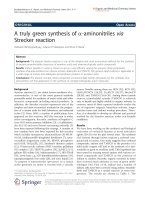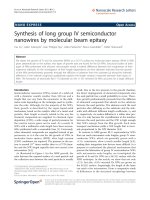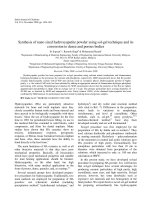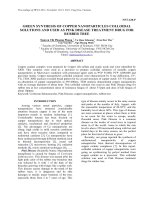Green synthesis of silver nanoparticles using extract of Parkia speciosa Hassk pods assisted by microwave irradiation
Bạn đang xem bản rút gọn của tài liệu. Xem và tải ngay bản đầy đủ của tài liệu tại đây (1.99 MB, 9 trang )
Journal of Advanced Research (2016) 7, 961–969
Cairo University
Journal of Advanced Research
ORIGINAL ARTICLE
Green synthesis of silver nanoparticles using extract
of Parkia speciosa Hassk pods assisted by
microwave irradiation
Is Fatimah
Chemistry Department, Universitas Islam Indonesia, Kampus Terpadu UII, Jl. Kaliurang km 14, Sleman, Yogyakarta
55584, Indonesia
G R A P H I C A L A B S T R A C T
A R T I C L E
I N F O
Article history:
Received 25 June 2016
Received in revised form 3 October 2016
Accepted 7 October 2016
Available online 15 October 2016
Keywords:
Ag NPs
A B S T R A C T
This paper reports an investigation of the microwave-assisted synthesis of silver nanoparticles
(Ag NPs) using extract of stinky bean (Parkia speciosa Hassk) pods (BP). The formation of
Ag NPs was identified by instrumental analysis consists of UV–vis spectrophotometry,
Fourier-transform infrared (FTIR) spectrophotometry, scanning electron microscopy (SEM),
transmission electron microscopy (TEM) and particle size analysis. Furthermore, Ag NPs were
used as antibacterial agents against Escherichia coli, Staphylococcus aureus, and Pseudomonas
aeruginosa. The results indicate rapid formation of Ag NPs during microwave irradiation with
similar properties to those obtained through the aging method. In general, the use of microwave
E-mail address:
Peer review under responsibility of Cairo University.
Production and hosting by Elsevier
/>2090-1232 Ó 2016 Production and hosting by Elsevier B.V. on behalf of Cairo University.
This is an open access article under the CC BY-NC-ND license ( />
962
irradiation yields larger particles, and it is affected by volume ratio of the extract to the AgNO3
solution. The prepared materials demonstrated antibacterial activity.
Ó 2016 Production and hosting by Elsevier B.V. on behalf of Cairo University. This is an open
access article under the CC BY-NC-ND license ( />4.0/).
Introduction
Nanotechnology has become a popular and necessary technology in recent years. Nanotechnology itself addresses nanoparticles that are atomic or molecular aggregates characterized by
size of less than 100 nm. The application of nanotechnology in
medical
applications,
commonly
referred
to
as
‘‘nanomedicine”, seeks to deliver a new set of tools, devices
and therapies for the treatment of human disease. Nanomaterials that can act as biological mimetics, ‘‘nanomachines”, biomaterials for tissue engineering, shape-memory polymers as
molecular switches, biosensors, laboratory diagnostics and
nanoscale devices for drug release, are just a few of the applications being explored [1]. Some nanoparticles have been
reported as having therapeutic potential. For example, in cancer detection, silver and gold nanoparticles were utilized. In
other cases, nanoparticles such as silver, gold, and ZnO were
used as antibacterial agents and some therapeutic uses [2–4],
in conjunction with some routes and simple technique for
developing nanoparticle synthesis. Of the nanoparticles used
in the pharmaceutical industry, silver nanoparticles are one
of the important materials in nanomedicine. Silver nanoparticles (Ag NPs) have been used as antibacterial agents for topical
application for bacterial skin infections [5,6]. In other cases,
Ag NPs have received much attention for their potential use
in cancer therapy from many reports showing that Ag NPs
effectively induce selective killing of cancer cells as well as play
a role in drug delivery. The synthesis of Ag NPs can be conducted by many routes, and the most used route is the chemical reduction of Ag+ ions from aqueous solution. The most
popular reducing agent for mild condition is sodium borohydride (NaBH4). Many investigations suggest several synthesis
routes using plant extracts as reducing agents instead of
NaBH4 in a green synthesis or biosynthesis scheme for Ag
NPs. Use of extract of Neem (Azadirachta indica L), Acalypha
indica, Azadirachta, Emblica and Cinnamomum Emblica officianalis, lemongrass and other potential plants has been
reported [7–15]. The specific compounds that act as reducing
agents and support the antimicrobial activity of Ag NPs are
generally flavonoids and polyphenol compounds. Another
method of green synthesis is the use of more effective, energy
efficient and rapid methods of preparation. Microwave irradiation (MW), sonochemistry and other rapid techniques have
been used [16–21]. In previous reports, MW has been utilized
for synthesis of Ag NPs, ZnO NPs, magnetite, TiO2 and other
nanoparticles with some advantages, the most important being
the rapid and efficient nature of the procedure [10,14,22–26].
With different rates of nanoparticles formation, the use of
MW also can be used to generate different morphologies
[27]. For example, MW-assisted synthesis of ZnO gives a
flower-like morphology that is influenced by the radiation
power [28].
Here, we investigated the use of the stinky bean or Parkia
speciosa Hassk. a plant indigenous to Southeast Asia including
Indonesia [29]. It is reported that the stinky bean and its pods
contain antioxidant, vitamin, oil and poly phenolic compounds. Traditionally, the stinky bean and its hull are used
as an itch remedy. From previous research, the chemical composition of stinky bean pods includes active organic compounds such as flavonoids, saponins, and tannins. The
phenolic content of BP extract was reported to be approximately 50–85 wt.%, and the flavonoid content is approximately 5–6 wt.% [30–32]. Due to the possible potency of BP,
this study aimed to investigate the utilization of SB extract
as reducing agent in Ag NPs synthesis. In addition, the effect
of the use of MW and the concentration of BP extract on
Ag NP characteristics was studied. Through the comparison
with the formation without MW (aging method), the rate
and profile of NPs are intensively discussed in light of their
antibacterial activity against Escherichia coli, Staphylococcus
aureus, and Pseudomonas aeruginosa. Considering green chemistry principles, simple extraction of the raw material was conducted by using water as solvent. The effect of parameter
synthesis, the volume ratio of the SB extract to AgNO3 solution to the NPs formation, was also investigated.
Material and method
Materials
SBP extract was obtained from stinky beans cultivated in Sleman district, Yogyakarta Province, Indonesia. Identification
of the stinky bean was performed by the Laboratory of Plant
Taxonomy, Faculty of Biology, Gadjah Mada University. The
empty BP samples were air dried before extraction. Ten grams
of BP was refluxed in 100 mL water for 2 h to obtain the BP
extract. Silver nitrate (AgNO3) (ACS reagent, P99.0%) and
Chloramphenicol (ACS reagent, P99.0%) were purchased
from Sigma Aldrich Co. (St. Louis, MO, USA), and E. coli,
S. aureus, and P. aeruginosa were supplied by ATCC Company
1
Ag NPs-mw
BP extract
0.8
Ag NPs-aging
Absorbance
Antibacterial agent
Green synthesis
Parkia speciosa Hassk
Microwave
Nanoparticles
I. Fatimah
0.6
0.4
0.2
0
300
350
400
450
500
550
wavelength (nm)
Fig. 1
UV–vis spectra of BP extract and the Ag NPs.
600
Green synthesis of silver nanoparticles using extract of Parkia speciosa Hassk pods
Fig. 2
SEM-EDX profile (a) Ag NPs-aging and (b) Ag NPs-mw.
963
964
I. Fatimah
Fig. 3
TEM profile of (a) Ag NPs-aging and (b) Ag NPs-mw.
(Manassas, VA, USA) and stored at the Microbiology Laboratory, Department of Pharmacy, Universitas Islam Indonesia.
Deionized water (produced by Integrated Laboratory, Universitas Islam Indonesia) was used throughout.
terial activity, the volume ratio in AgNPs-mw preparation was
varied at 10:1, 20:1 and 40:1.
Synthesis of silver nanoparticles (Ag NPs)
UV-absorption spectra of synthesized Ag NPs were characterized using a HITACHU U-2010 UV–vis spectrometer, HITACHI (Tokyo, Japan). Scanning electron microscopy (SEM)
analysis was conducted using Philip XL 30, SEMTech (Tokyo,
Japan) and transmission electron microscopy (TEM) was performed using JEOL-JEM 1400 (Freising, Germany). The particle size distributions of the synthesized Ag NPs were
determined by the particle size analyzer HORIBA-X, HORIBA Scientific (Kyoto, Japan). Fourier transform infrared
(FTIR) spectral measurements using FTIR-UATR Spectrum
Two, Perkin Elmer (Massachusetts, USA) were carried out
to identify the functional groups contained in the BP extract.
The XRD pattern of Ag NPs was obtained with a Shimadzu
X-6000 (Kyoto, Japan) instrument and the Rietveld refinement
was conducted by using Rietica. The solvent of the Ag NPs liquid sample was evaporated, and the powder was dispersed
onto a glass film before analysis.
Aqueous solution (10À3 M) of silver nitrate (AgNO3) was prepared in 250 mL Erlenmeyer flasks, and BP extract was added
for reduction into Ag+ ions. The mixture was then heated in a
microwave oven for complete bioreduction at a power of
300 W for 4 min. A commercial MW oven with a 2.45 GHz
frequency was used. The color change of the SBP extract from
light yellowish to reddish brown was recorded by UV–vis spectrophotometric analysis. As a comparison, the same mixture
was prepared and aged for 24 h before being monitored using
UV–vis spectrophotometry. For XRD and SEM analysis, the
solution was filtered to yield fine particles to be thin filmed
on the glass surface. The Ag NPs obtained from the microwave
irradiation and aging methods are designated as Ag NPs-mw
and Ag NPs-aging, respectively. In order to evaluate the effect
of the volume ratio of the silver nitrate solution with respect to
the BP extract on the particle size distribution and its antibac-
Nanoparticle characterization
Green synthesis of silver nanoparticles using extract of Parkia speciosa Hassk pods
Fig. 4
FTIR spectra of (a) BP extract, (b) Ag NPs-aging and (c) Ag NPs-mw.
965
966
I. Fatimah
Fig. 5
XRD pattern of AgNPs-aging (above) and Ag NPs-mw (below).
Antibacterial activity of Ag NPs
The antibacterial activity of the extract and Ag NPs was measured for E. coli, S. aureus, and P. aeruginosa by the disk diffusion method. The disks were soaked with double distilled
water, BP extract and the Ag NP solution separately. Varied
concentrations of the Ag NPs were used to ensure identification of the antibacterial activity. The disks were air dried in
sterile conditions before being placed in agar media containing
the microbial cultures. Plates containing media as well as cultures were divided into four equal parts and previously prepared disks were placed on each part of the plate. The disk
soaked with double distilled water was utilized as the negative
control, and disk soaked with chloramphenicol (30 lg/mL)
was used as the positive control. The plates were incubated
at 37 °C for 24–48 h. The maximum zone of inhibition was
observed and measured for analysis against each type of test
microorganism.
Results and discussion
Ag NPs characterization
The UV–vis spectra of BP extract and the Ag NPs are displayed in Fig. 1. The extract color change from yellowish to
reddish brown was exhibited by Ag reduction, also from the
UV–vis spectra there are blue shifts of the spectra after the
reduction. The absorption spectra of the extract are in the
range of 271–273 nm while Ag NPs formed by both method
have a peak wavelength of 445 nm. These changes are due to
the rapid change of the surface plasmon resonance of Ag
NPs. This change is denoted by the broadening of the peak,
which indicates the formation of polydispersed large nanoparticles due to slow reduction rates. Ag NPs-mw exhibits the
higher absorbance than Ag NP-aging in the maximum wavelength implied that more rapid bioreduction was achieved.
Visually the final color of Ag NPs-mw is darker compared to
Ag NPs-aging.
SEM profiles of the drop coated films of Ag NPs with varied magnifications are depicted in Fig. 2. The images present
the aggregate formation of Ag NPs with spherical-like formation by both methods. EDS analysis confirms that the aggregates are silver nanocrystals in that typical optical
absorption peak is shown at approximately 3 keV. The
aggregate formation in SEM analysis is related to the sample
preparation procedure to the sample in that the nanoparticles
need to be filtered and dried before measurement. Different
surface morphology of the particles is found from varied methods in which the flake type is obtained from microwave
assisted Ag NPs while the aging method presents sphericallike aggregates. The EDX analysis of the silver nanoparticles
revealed only Ag content indicating no silver oxide formation.
Green synthesis of silver nanoparticles using extract of Parkia speciosa Hassk pods
967
20
25
18
16
14
Frequency
Frequency
20
15
10
12
10
8
6
4
5
2
0
19.03
21.5
24.29
27.45
31.01
35.03
39.58
44.72
50.53
57.09
64.5
72.87
82.33
93.341
105.1
118.74
134.16
151.57
171.25
193.48
218.6
246.98
19.03
21.5
24.29
27.45
31.01
35.03
39.58
44.72
50.53
57.09
64.5
72.87
82.33
93.02
105.1
118.74
134.16
151.57
171.25
193.48
218.6
246.98
356.05
0
(a)
(c)
diammeter (nm)
30
25
25
Frequency
20
Frequency
Diammeter (nm)
15
10
20
15
10
5
5
0
19.03
21.5
24.29
27.45
31.01
35.03
39.58
44.72
50.53
57.09
64.5
72.87
82.33
93.341
105.1
118.74
134.16
151.57
171.25
193.48
218.6
246.98
19.03
21.5
24.29
27.45
31.01
35.03
39.58
44.72
50.53
57.09
64.5
72.87
82.33
93.02
105.1
118.74
134.16
151.57
171.25
193.48
218.6
246.98
356.05
0
(b)
Fig. 6
Table 1
(d)
Diammeter (nm)
Diammeter (nm)
Particle size distribution of (a) Ag NPs-aging and (b–d) Ag NPs-mw with the volume ratio of 10:1, 20:1 and 40:1 respectively.
Results of antibacterial activity test of SBP extract and AgNPs.
Antibacterial agent
SBP extract
AgNPs-aging
AgNPs-mw
10:1
20:1
40:1
Chloramphenicol (positive control)
Double distilled water (Negative control)
Inhibition zone (mm) after incubation for 24 h
S. aureus
E. coli
P. aeruginosa
7.3
6.9
7.6
7.6
7.6
8.6
8.6
6.8
6.8
23.6
0.0
10.4
8.2
8.2
23.8
0.0
11.8
9.8
8.3
7.6
0.0
TEM profiles in Fig. 3 also show that the formed Ag NPs are
in the range of nanoparticle size at around 20–50 nm. The
TEM images exhibits the mixture of shapes with mainly spherical shapes are predominant. Also from the images, thin layer
of organic material from plant is observed as well as reported
by some previous reports utilizing plant extracts [33,34].
Comparison on the FTIR spectra of the BP extract and Ag
NPs is displayed in Fig. 4. The FT-IR spectra of BP extract
show several major peaks at 3292, 2917, 2849, 2112, 1742,
1630, 1420, 1375, 1147 and 1043 cmÀ1 and some other peaks
approximately at 1000 cmÀ1. The peak at 3292 cmÀ1 repre-
sents the AOH stretching vibration from phenolic compounds
in the extract while the three peaks at 2849, 1375 and
1043 cmÀ1 are probably attributable to the NH stretching
vibration of amide II, CAO stretch and CAN stretching of
amines, respectively. The peak at 1630 cmÀ1 is designated as
the stretching vibration of C‚O bond. After the Ag NPs formation, there are some shifts of valuable peaks such as the OH vibration from 3292 to 3306 cmÀ1, C‚O vibration from
1630 to 1634 cmÀ1, and NAH vibration from 1043 to
1045 cmÀ1, indicating that reduction occurred. Overall, the
spectra of Ag NPs-mw and Ag NPs-aging are similar.
968
I. Fatimah
The presence of silver is also confirmed by the XRD patterns in Fig. 5. The characteristics of diffraction peaks at
38.28°, 44.33°, 64.33°, and 77.53° correspond to the (1 1 1),
(2 0 0), (2 2 0) and (3 1 1) planes, respectively. The peaks are in
good agreement with face centered cubic (FCC) silver with a
lattice parameter of a = 4.08 A˚, which is also in agreement
with the joint committee of powder diffraction standard
(JCPDS) Card No-087-0720 data [16]. From the Rietveld
refinement, the patterns also confirm that no oxide Ag species
formed. From the calculation using the Scherrer’s formula for
the crystallite domain size:
D ¼ 0:94k=b cos h
ð1Þ
The crystallite size is calculated to be approximately 18 nm
and 17 nm. The Ag NPs-mw are slightly bigger than Ag NPsaging.
Fig. 6 presents the particle size distributions of Ag NPs prepared by different methods and the volume ratio of silver solution to SBP extract. With the same volume ratio, the results
showed that the particle size distribution of Ag NPs-mw has
a larger size (114.41 nm) than Ag NPs-aging (104.38 nm).
The distribution suggests the formation of particle aggregates
with increasing energy transfer during the rapid reduction
reaction caused by microwave irradiation. The variation of
the volume ratio indicates that the higher the concentration
of SBP extract, the smaller particle size diameter distribution
of the Ag NPs will be. The particle size distribution means
are 114.41 nm, 127.60 nm and 160.67 nm for the ratio of
10:1; 20:1 and 40:1, respectively. The data suggest that the
reduction mechanism is controlled by the amount of reducing
agent.
Ag NPs antibacterial activity
Although the mechanism for the antimicrobial action of silver
ions is not clearly understood, quantum size effect of silver
ions on microbe is reported from several investigations. The
effect of Ag NPs synthesis parameters on the antimicrobial
activity compared with SBP extract, double distilled water as
negative control and chloramphenicol as positive control is
expressed by the data in Table 1.
Ag NPs demonstrate higher antibacterial activity than the
SBP extract for all tested microbes. Ag NPs exhibit high
activity against P. aeruginosa as shown by the wider inhibition zone compared to chloramphenicol as the positive control while for the other microbes the activity of Ag NPs is
between the SBP extract and chloramphenicol. The results
of the varied volume ratio show that the higher ratio exhibits the lowest antibacterial activity. This phenomenon is
in line with the particle size distribution resulting from the
variable ratio. It has been reported that the smaller particle
size contributes to more effective interaction and interference
with microbial DNA [14].
Conclusions
Synthesis of stinky bean pod extract reduced Ag NPs with the
microwave irradiation method and the effect of extract concentrations were studied. Microwave irradiation provides rapid
formation of Ag NPs with larger particle size compared to
aging method. The concentration of the extract affects the par-
ticle size distribution, as well as antibacterial activity against S.
aureus, E. coli and P. aeruginosa.
Conflict of Interest
The author has declared no conflict of interest.
Compliance with Ethics Requirements
This article does not contain any studies with human or animal
subjects.
Acknowledgments
The author acknowledges with thanks the Department of
Chemistry, Universitas Islam Indonesia for providing the
financial assistance in the research activity, Dara Safrina for
bean photograph and the Nanopharmacy Research Center,
Universitas Islam Indonesia for use of the particle size analysis
instrument.
References
[1] Hartemann P, Hoet P, Proykova A, Fernandes T, Baun A, De
Jong W, et al. Nanosilver: safety, health and environmental
effects and role in antimicrobial resistance. Mater Today
2015;18:122–3.
[2] Pati R, Mehta R, Mohanty S, Padhi M, Sengupta M,
Vaseeharan B, et al. Topical application of zinc oxide
nanoparticles reduces bacterial skin infection in mice and
exhibits antibacterial activity by inducing oxidative stress
response and cell membrane disintegration in macrophages.
Nanomedicine 2014;10:1195–208.
[3] Bankar A, Joshi B, Kumar AR, Zinjarde S. Banana peel extract
mediated novel route for the synthesis of silver nanoparticles.
Colloid Surf A 2010;368:58–63.
[4] Siva Vijayakumar T, Karthikeyeni S, Vasanth S, Ganesh A,
Bupesh G, Ramesh R, et al. Synthesis of silver-doped zinc oxide
nanocomposite by pulse mode ultrasonication and its
characterization studies. J Nanosci 2013;2013:1–7.
[5] Ma L, Jia I, Guo X, Xiang L. Catalytic activity of Ag/SBA-15
for low temperature gas phase selective oxidation of benzyl
alcohol to benzaldehyde. Chinese J Catal 2014;35:108–19.
[6] Gopinath PM, Narchonai G, Dhanasekaran D, Ranjani A,
Thajuddin N. Mycosynthesis, characterization and antibacterial
properties of AgNPs against multidrug resistant (MDR)
bacterial pathogens of female infertility cases. Asian J Pharm
Sci 2015;10:138–45.
[7] Khalil MMH, Ismail EH, El-Baghdady KZ, Mohamed D.
Green synthesis of silver nanoparticles using olive leaf extract
and its antibacterial activity. Arabian J Chem 2014;7:1131–9.
[8] Dhand V, Soumya L, Bharadwaj S, Chakra S, Bhatt D,
Sreedhar B. Green synthesis of silver nanoparticles using
Coffea arabica seed extract and its antibacterial activity.
Mater Sci Eng C 2016;58:36–43.
[9] Honary S, Barabadi H, Gharaei-Fathabad E, Naghibi F. Green
synthesis of silver nanoparticles induced by the fungus
penicillium citrinum. Tropical J Pharm Res 2013;12:7–11.
[10] Vasireddy R, Paul R, Krishna A. Green synthesis of silver
nanoparticles and the study of optical properties. Nanomate
Nanotechnol 2012;2:1.
[11] Sharma G, Sharma AR, Kurian M, Bhavesh R, Nam JS, Lee SS.
Green synthesis of silver nanoparticle using Myristica fragrans
Green synthesis of silver nanoparticles using extract of Parkia speciosa Hassk pods
[12]
[13]
[14]
[15]
[16]
[17]
[18]
[19]
[20]
[21]
[22]
(nutmeg) seed extract and its biological activity. Digest J
Nanomater Biostruct 2014;9:325–32.
Muniyappan N, Nagarajan NS. Green synthesis of gold
nanoparticles using Curcuma pseudomontana essential oil, its
biological activity and cytotoxicity against human ductal breast
carcinoma cells T47D. J Environ Chem Eng 2014;2:2037–44.
Umoren SA, Obot IB, Gasem ZM. Green synthesis and
characterization of silver nanoparticles using red apple (Malus
domestica) fruit extract at room temperature. J Mater Environ
Sci 2014;5:907–14.
Velusamy P, Das J, Pachaiappan R. Greener approach for
synthesis of antibacterial silver nanoparticles using aqueous
solution of neem gum (Azadirachta indica L.). Ind Crops
Products 2015;66:103–9.
Moosa AA, Ridha AM, Al-kaser M. Process parameters for
green synthesis of silver nanoparticles using leaves extract of
aloe vera plant. Int J Mutidiciplinary Current Res
2015;3:966–75.
Joseph S, Mathew B. Microwave-assisted green synthesis of
silver nanoparticles and the study on catalytic activity in the
degradation of dyes. J Mol Liq 2015;204:184–91.
Ma Y, Pang Y, Liu F, Xu H, Shen X. Biomolecular
spectroscopy microwave-assisted ultrafast synthesis of silver
nanoparticles for detection of Hg 2 +. Spectrochimica Acta A
2016;153:206–11.
Raghavendra GM, Jung J, Seo J. Microwave assisted
antibacterial chitosan – silver nanocomposite films. Int J Biol
Macromol 2016;84:281–8.
Nazeruddin GM, Prasad NR, Prasad SR, Shaikh YI,
Waghmare SR, Adhyapak P. Coriandrum sativum seed extract
assisted in situ green synthesis of silver nanoparticle and its antimicrobial activity. Ind Crops Prod 2014;60:212–6.
Dar N, Chen K-Y, Nien Y-T, Perkas N, Gedanken A, Chen IG. Sonochemically synthesized Ag nanoparticles as a SERS
active substrate and effect of surfactant. Appl Surf Sci
2015;331:219–24.
Dutta DP, Tyagi AK. Facile sonochemical synthesis of Ag
modified Bi4Ti3O12 nanoparticles with enhanced photocatalytic
activity under visible light. Mater Res Bull 2016;74:397–407.
Pati SS, Kalyani S, Mahendran V, Philip J. Microwave assisted
synthesis of magnetite nanoparticles. J Nanosci Nanotechnol
2014;14:5790–7.
969
[23] Vankar PS, Shukla D. Biosynthesis of silver nanoparticles using
lemon leaves extract and its application for antimicrobial finish
on fabric. Appl Nanosci 2012;2:163–8.
[24] Vijayashree IS, Yallappa S, Niranjana P, Manjanna J.
Microwave assisted synthesis of stable biofunctionalized silver
nanoparticles using apple fruit (Malus domestica) extract. Adv
Mater Lett 2014;4:598–603.
[25] Wang B, Zhuang X, Deng W, Cheng B. Microwave-assisted
synthesis of silver nanoparticles in alkalic carboxymethyl
chitosan solution. Engineering 2010;2:387–90.
[26] Wang X, Tian J, Fei C, Lv L, Wang Y, Cao G. Rapid
construction of TiO2 aggregates using microwave assisted
synthesis and its application for dye-sensitized solar cells. RSC
Adv 2015;5:8622–9.
[27] Yin H, Yamamoto T, Wada Y, Yanagida S. Large-scale and
size-controlled synthesis of silver nanoparticles under
microwave irradiation. Mater Chem Phys 2004;83:66–70.
[28] Hasanpoor M, Aliofkhazraei M, Delavari H. Microwaveassisted synthesis of zinc oxide nanoparticles. Proc Mater Sci
2015;11:320–5.
[29] Hasima, Faridah DN, Kurniawati DA. Antibacterial activity of
Parkia speciosa Hassk peel to Escherichia coli and Staphylococcus
aureus bacteria. J Chem Pharm Res 2015;7:239–43.
[30] Aisha A, Abu-Salah’ KM, Alrokayan SA, Majid AMSA.
Evaluation of antiangiogenic and antoxidant properties of
Parkia speciosa Hassk extracts. Pakistan J Pharm Sci
2012;4:7–14.
[31] Wonghirundecha S, Soottawat B, Sumpavapol P. Total phenolic
content, antioxidant and antimicrobial activities of stink bean
(Parkia speciosa Hassk) pod extracts. Songkl J Sci Technol
2014;36:301–8.
[32] Aden AZ, Mawardika H, Vilansari N, Agustin F, Silvana GT.
Uji Efektivitas Ekstrak Kulit Petai(Parkia speciosa Hassk) pada
Mencit Balb sebagai Obat Anti-imflamasi Rheumatoid Arthitis;
Universitas Brawijayamalang, Malang, 2013.
[33] Roy S, Das TK. Plant mediated green synthesis of silver
nanoparticles – a review. Int J Plant Biol Res 2015;3.
[34] Ahmed S, Ahmad M, Swami BL, Ikram S. A review on plants
extract mediated synthesis of silver nanoparticles for antimicrobial
applications: a green expertise. J Adv Res 2016;7:17–28.









